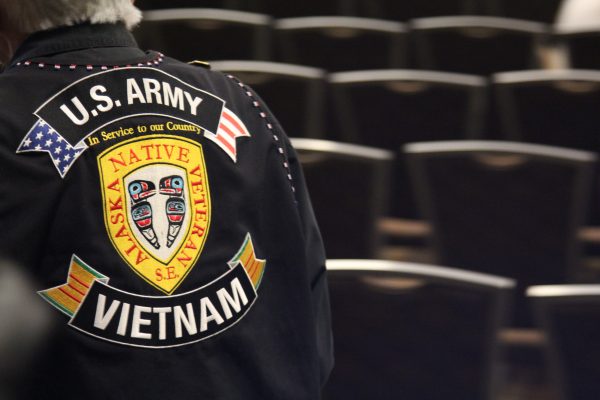
It’s common to hear public officials say that Alaska Natives join the Armed Forces at the highest rates in the country. It was something Department of Veterans Affairs Secretary Robert Wilkie mentioned in his speech last month at the Alaska Federation of Natives in Anchorage.
“You serve in the military of the United States at a higher rate than any group of Americans,” Wilkie said.

During World War II and the following decades, American Indians and Alaska Natives did indeed volunteer for the Armed Forces at exceptionally high rates. But that has declined over time. A big part of that change has to do with transformations in the structure of the military at large — in particular the National Guard.
Growing up in the New Stuyahok, 24-year-old Lawrence Gust never planned on signing up for the Alaska Army National Guard.
“From my village, it’s not really been a thing for anyone to join the military, so it wasn’t anything for younger children to look up to,” Gust said.
One reason is that the ongoing wars overseas have left many parents in the region worried about the dangers of enlisting.
But during a school trip to Dillingham, the Bristol Bay region’s hub, Gust encountered recruiters from the National Guard, and it planted the idea of joining as a way to help pay for college, get training and travel.
Now, three years since enlisting, he is part of a small group of young people from New Stuyahok in the Guard.
“Recruiters are now traveling out to villages and giving presentations and things like that,” Gust said. “Sparking an interest in the younger kids at home. Really, National Guard just needed to be heard from in the villages.”
Gust is exactly who the state wants as it tries to rebuild the shrunken National Guard presence off the road system. A rural engagement program has been underway for the last few years, meant to draw on both veterans living in the Bush, as well as younger residents; more like how Alaska’s National Guard was in the past.
“It was very common to see fatigues and the bunny boots anywhere out (in) the Bush,” recalled Michelle Sparck. She grew up between Bethel and Chevak in the Yukon-Kuskokwim Delta region, and has been part of policy discussions on the Guard in the state Legislature.
In the past, residents in rural regions joined the military in large numbers. Part of the draw for many residents was the organization’s roots in Alaska’s storied Territorial Guard, World War II.
The organization’s structure and mission kept folks in state, rather than activating them for far-away assignments; a factor that made service more convenient.
“It was pretty easy for people to sign up for the National Guard, because it kind of fit our subsistence way of life. You had schedules and training that were kind of intermittent, so you could still go back home and commit to subsistence and providing for your families,” Sparck said.
A number of things have since changed.
The size of Alaska’s Army National Guard has shrunk by more than half since the 1990s, and is now concentrated along the road system. During the Cold War there were more than a hundred small armories around the state. This summer, the state announced it wants to shed 60 armories, most in small rural communities. And in 2006, Alaska guardsmen were activated for the first time since World War II, deployed to Iraq and Afghanistan, which was a jolt to rural families.
“I think that kinda changed the culture a little bit, about people committing, making that kind of commitment to the government,” Sparck said.
“We had a strong National Guard. We had armories in most of our villages across the state,” explained Verdie Bowen, Director of the state’s Office of Veteran Affairs. “It was not uncommon to go into a village and have most of the people involved with the Alaska Army National Guard.”
Bowen grew up in rural southeast Alaska before joining the Air Force after high school. From his work he knows the state’s veteran population well, and he could not offer definitive verification that Alaska Natives still serve at the highest rate in the country, or even among different demographic groups within Alaska.
Current data from the Census Bureau, Department of Veterans Affairs, and Defense Department suggest that long-held claim, though widely cited, is no longer true.
A steep decline in Alaska Native rates of service isn’t only due to changes in the state’s National Guard, but the military over all. The Armed Forces have become more selective. Recruiters are having a hard time finding enough young Americans of any ethnicity who are in good enough shape, meet the educational requirements, or can pass a drug test in order to join.

For example, the Army has much higher enlistment standards than it did in 1969. That’s the year a judge in Fairbanks gave Benno Cleveland a choice between jail or the infantry.
“I was a little rambunctious when I was a younger man,” Cleveland recounted.
Cleveland did two tours in the Mekong Delta during the height of the Vietnam War, receiving two purple hearts. He believes the Army was good for him. It was a way to see different parts of the world, and he found that the training emphasized many of the same values he knew from his Inupiaq heritage.
“It’s the same thing as any culture. Our elders, they’ve taught us to be good, to be respectful, to work for what we want, to help other people,” he explained.
Cleveland credits the combination of his indigenous culture, the military community and his faith with helping him make it through years of struggle to process his combat experience. He wears regalia mixed with indigenous icons and military insignia. Even amid sweeping changes in the armed forces he thinks they offer young Alaska Natives a similar set of opportunities for advancement, and service to lands where indigenous people have long lived.
“This is our home. Our people have been here forever,” Cleveland said.
Whether military institutions can find new ways to fit that will to serve with the needs of Alaska Native communities remains to be seen.
Correction: an earlier version of this story said that the legislature had cut DMVA’s budget, hampering rural outreach. While the department’s budget has been reduced, federal funds have been used to maintain, and in some cases increase, rural recruitment efforts.
Zachariah Hughes reports on city & state politics, arts & culture, drugs, and military affairs in Anchorage and South Central Alaska.
@ZachHughesAK About Zachariah




